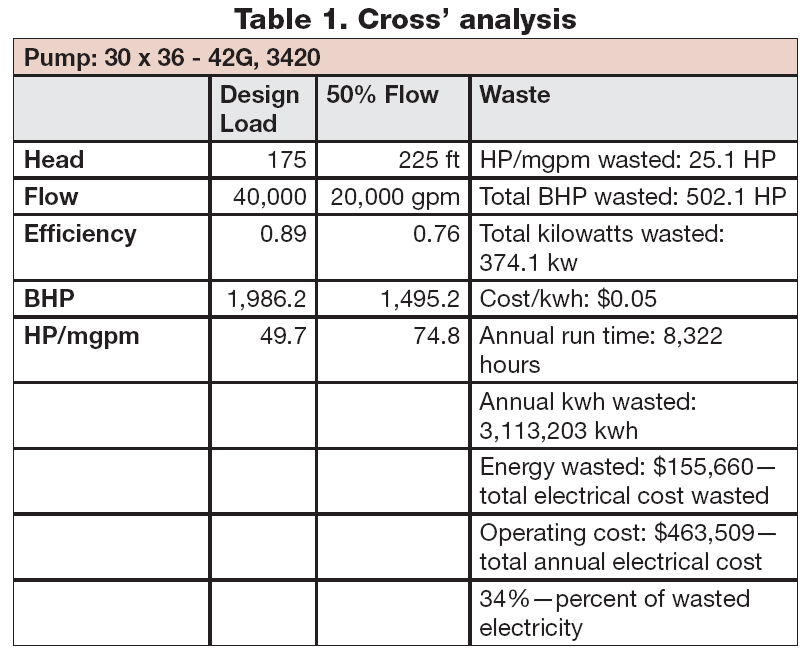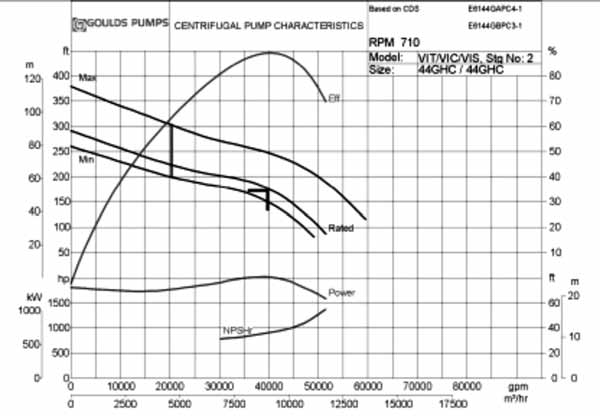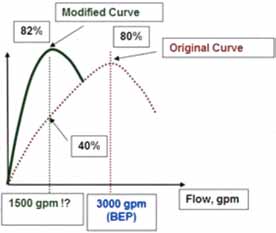We all know that a pump operating at off-design (to the left or right of the best efficiency point—BEP) flow wastes energy. But how much?
Such questions face pump users all the time. Let's take a specific question presented by a reader: How much energy is wasted when his 2,000 horsepower pump operates at 50 percent of flow?
The Reader's Assessment
Total wasted energy is a function of pump efficiency and total dynamic head (TDH). Since TDH increases with decreased flow and hydraulic efficiency decreases when operating away from BEP, both the estimated head increase and efficiency loss must be included in the energy loss calculation. A typical 2,000 horsepower cooling water pump operating at 75 feet TDH and 89 percent efficiency requires approximately 50 brake horsepower (BHP) per thousand gallons per minute (gpm) flow. Reducing the flow by 50 percent increases the TDH to about 225 feet, and the efficiency drops from 89 percent to 76 percent which results in approximately 75 BHP per thousand gpm flow. The total power wasted is approximately 500 horsepower, and the BHP required to operate at 50 percent flow is 1,500 horsepower. At $0.05/kilowatt hour and 95 percent annual operation, the annual electricity wasted is $155,660 or approximately 34 percent of the BHP required to operate the pump.
Sincerely,
Tim Cross
Sr. Mechanical Engineer II
Georgia Gulf Chemicals & Vinyls LLC
Vertical Turbine Pump Analysis
I enjoyed Tim's deep and detailed analysis. He used a double suction split case pump for the analysis, but in fact, any other pump type of that size and power from any manufacturer would produce the same results. I thought it would be helpful to see a performance curve, for ease of following along with the numbers. Goulds Pumps has a nice computerized performance selection program online, so I picked it for illustration purposes, as shown in Figure 1. I selected a vertical turbine pump, to show the similarities in results with Tim's double suction pump. The numbers differ slightly from his but are reasonably close for the comparison purposes.
Tim's pump's BEP is 89 percent, which is close to the 88 percent BEP shown on the curve in Figure 1. At these power levels for vertical turbine pumps, most manufacturers show a bowl efficiency not a true pump efficiency and do not account for discharge piping losses, which typically amount to an additional efficiency decrease of about 2 to 3 percent.
At 50 percent flow, Tim's numbers show 76 percent efficiency, and the vertical turbine pump in Figure 1 had an even greater decline to approximately 61 percent. Because of this, the cost difference/wasted energy that he presented would be even more dramatic for this pump. Also, Tim used a $0.05 per kilowatt hour energy cost, which is probably generous, and I applied about $0.08 per kilowatt hour. With energy prices rising, this would likely not get any better. Tim's point will be even more relevant over time.
The good news is that many people are beginning to realize this rather grim picture of pump energy troubles. Unfortunately, few of those who do realize it have gone beyond generalities and actually evaluated the numbers, as Tim did. Energy, indeed, does matter, and this is why.
Unfortunately, in practice, the best thing that happens is a replacement of one pump with another—a smaller one in this case. A 40,000-gpm (BEP) pump would be replaced by a 20,000-gpm (BEP) pump. It is true that a smaller pump would then operate at improved efficiency, with savings as presented. However, the investment by the end user is considerable—an expensive, new pump, and even more dramatic, modifications and changes to the piping to accommodate a new pump. When all the economics are evaluated, the payback period may be many years. This negates or significantly offsets the apparent energy savings.

Table 1. Cross' Analysis

Figure 1. Pump curve
A Different Approach to Replacement
A better approach is to keep the same pump but to replace only the impeller with specially designed hydraulics to fit the proper required flow and to account for the existing geometry of the casing. Such an approach is much less expensive and quicker and requires no piping modifications. Of course, good knowledge of pump hydraulics to design this type retrofit is required, but that is why training needs are to be emphasized. These days, achieving significant benefits with regard to energy conservation is not possible with quick, superficially-appealing methods—such as an entire pump replacement—alone. Clearly, a more rounded, technically sound engineering design approach must be employed.

Figure 3. Original and modified pump curves
July Quiz
As always, a parting quiz. What would be the payback time (in months) for an impeller retrofit to shift the BEP flow from 3,000 gpm to 1,500 gpm for an 8 x 6 - 17 centrifugal pump coupled to a 300 horsepower motor—and assuming $0.10 energy cost and a $5,000 proposed project modification investment? (Compare this also to a $50,000-project proposed investment.) Refer also to Figure 3. (Hint: http://mj-integratedsolutions.com/Pump_Tools/PumpSavings.aspx)
Pumps & Systems, July 2011
Click here to see a Readers Response for this article.


